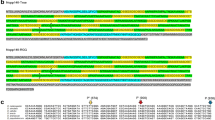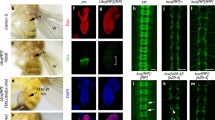Abstract
A full-length 1.8 kb cDNA of the Drosophila melanogaster gene prune together with the corresponding genomic sequence was cloned and sequenced. Comparison of the two sequences revealed the existence of the intron in the prune primary transcript. The putative prune protein is likely to have a single transmembrane domain. The nature of several prune mutant alleles was analysed: the size and quantity of prune mRNA were found to be decreased in pn 1 and pn 3 mutations. Mutations pn 1 and pn 54c were shown to be accompanied by insertions of the same novel mobile repeated element.
Similar content being viewed by others
References
Alatortsev VE (1987) Molecular and genetic analysis of the position-effect variegation in Drosophila melanogaster. Ph D Thesis, Institute of Molecular Genetics, Moscow (In Russian)
Bialojan S, Falkenburg D, Renkawitz-Pohl R (1984) Characterization and developmental expression of beta-tubulin genes in Drosophila melanogaster. EMBO J 3:2543–2548
Biggs J, Tripoulas N, Hersperger E, Dearolf C, Shearn A (1988) Analysis of the lethal interaction between the prune and Killer of prune mutations of Drosophila. Genes Dev 2:1333–1243
Biggs J, Hersperger E, Steeg P, Liotta L, Shearn A (1990) A Drosophila gene that is homologous to a mammalian gene associated with tumor metastasis codes for nucleoside diphosphate kinase. Cell 63:933–940
Bridges CB (1938) A revised map of the salivary gland X-chromosome of Drosophila melanogaster. J Hered 29:11–13
Cavener DR (1987) Comparison of the consensus sequence flanking translation start sites in Drosophila and vertebrates. Nucleic Acids Res 15:1353–1361
Chomezynski A, Sacchi G (1987) Single-step method of RNA isolation by acid guanidinium thiocyanate-phenol-chloroform extraction. Anal Biochem 162:156–159
Dayhoff MO, Barker WC, Hunt LT (1983) Establishing homologies in protein sequences. Methods Enzymol 91:524–545
Dumas C, Lascu I, Morera S, Glaser P, Fourme R, Wallet V, Lacombe M-L, Veron M, Janin J (1992) X-ray structure of nucleoside diphosphate kinase. EMBO J 11:3203–3208
Dura J-M, Randsholt N, Deatrick J, Erk I, Santamaria P, Freeman J, Freeman S, Weddell D, Brock H (1987) A complex genetic locus, polyhomeotic, is required for segmental specification and epidermal development in Drosophila melanogaster. Cell 51:829–839
Gaul U, Mardon G, Rubin G (1992) A putative Ras GTPase activating protein acts as a negative regulator of signaling by the sevenless receptor tyrosine kinase. Cell 68:1007–1019
Goldberg D (1980) Isolation and partial characterisation of the Drosophila alcohol dehydrogenase gene. Proc Natl Acad Sci USA 77:5794–5798
Haenlin M, Steller H, Pirrotta V, Mohier E (1985) A 43 kilobase cosmid P transposon rescues the fs(1)K10 morphogenctic locus and three adjacent Drosophila developmental mutants. Cell 40:821–831
Hultmark D, Klemenz R, Gehring W (1986) Translational and transcriptional control elements in the untranslated leader of the heat shock gene hsp22. Cell 44:429–438
Lindsley D, Zimm G (1992) The genome of Drosophila melanogaster. Academic Press, San Diego, pp 554–555
Mackay W, O'Donnell J (1983) A genetic analysis of the pteridine biosynthetic enzyme, guanosine triphosphate cyclohydrolase, in Drosophila melanogaster. Genetics 105:35–53
McLean J, Boswell R, O'Donnell J (1990) Cloning and molecular characterization of a metabolic gene with developmental functions in Drosophila. I. Analysis of the head function of Punch. Genetics 126:1007–1019
Mead DA, Szczesna-Scopura E, Kemper B (1986) Single-stranded “blue” T7 promoter plasmids: a versatile tandem promoter system for cloning and protein engineering. Protein Eng 1:67–74
O'Donnell J, McLean J, Reynolds E (1989) Molecular and developmental genetics of the Punch locus, a pterin biosynthesis gene in Drosophila melanogaster. Dev Genet 10:273–286
Pardue ML, Kedes LH, Weinberg ES, Birnstiel ML (1977) Localisation of sequence coding for histone messenger RNA in the chromosomes of D. melanogaster. Chromosome 63:135–151
Proudfoot N, Brownlee G (1976) 3′ Non-coding region sequences in eukaryotic messenger RNA. Nature 263:211–214
Rao JKM, Argos P (1986) A conformational preferences parameter to predict helices in integral membrane proteins. Biochim Biophys Acta 869:197–214
Sambrook J, Fritch EF, Maniatis T (1989) Molecular cloning: a laboratory manual. Cold Spring Harbor Laboratory, Cold Spring Harbor, New York
Sturtevant AG (1956) A highly specific complementary lethal system in Drosophila melanogaster. Genetics 41:118–123
Teng D, Bender L, Engele C, Tsubota S, Venkatesh T (1991a) Isolation and characterisation of the prune locus of Drosophila melanogaster. Genetics 128:373–380
Teng D, Engele C, Venkatesh T (1991b) A product of the prune locus of Drosophila is similar to mammalian GTPase-activating protein. Nature 353:437–440
Wang Y, Boguski M, Riggs M, Rodgers L, Wigler M (1991) Sar1, a gene from Schizosaccharomyces pombe encoding a protein that regulates ras1. Cell Regul 2:453–465
Author information
Authors and Affiliations
Additional information
Communicated by E. Bautz
Rights and permissions
About this article
Cite this article
Frolov, M.V., Zverlov, V.V. & Alatortsev, V.E. The mRNA product of the Drosophila gene prune is spliced and encodes a protein containing a putative transmembrane domain. Molec. Gen. Genet. 242, 478–483 (1994). https://doi.org/10.1007/BF00281800
Received:
Accepted:
Issue Date:
DOI: https://doi.org/10.1007/BF00281800




